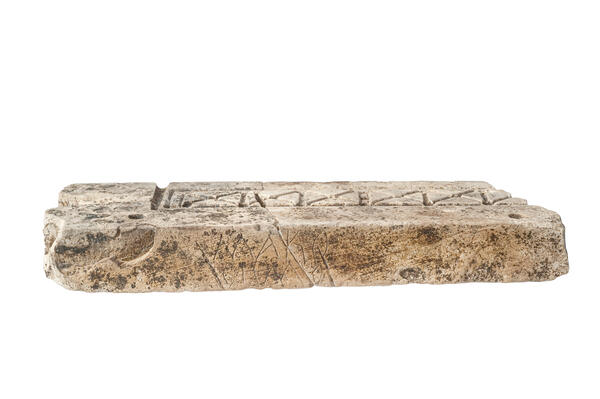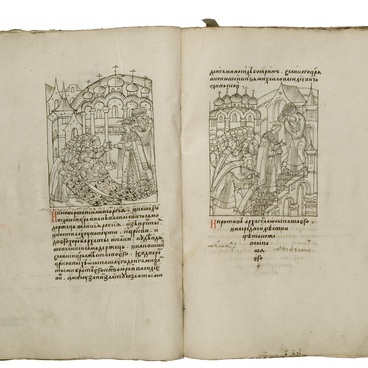The casting mold made of white limestone was discovered by archaeologists at the Serensk hillfort, Kaluga Oblast. An unknown master carved it in the 12th or the first half of the 13th century.
One side of the mold was intended for casting bangles. It has a pattern preserved on it: relief rectangles and oblique crosses. Archaeologists have suggested that on the other side of the mold, the master could cast wires or details with relief patterns running lengthwise for decorating headdresses.
Two parts glued together make up the casting mold. There is an inscription scratched in two lines on its side: “Mako simo”. Probably, this is a distorted name of the master — Maksim. The shape of the letters and the location of the inscription are very similar to the ones which were found on another similar mold in the crypt of the Church of the Tithes in Kiev. It was intended for casting temple rings with three beads — a popular female jewelry piece in Kievan Rus. Scientists believe that these two molds were made by the same Kiev master, and only later one of them was brought to Serensk.
Probably, in the ancient city, which was located on the site of the present-day Serensk hillfort, jewelry art was well developed. On this territory, archaeologists found more than 50 molds for casting — this is the second largest collection among all Old Russian finds. A greater number of similar items was found only in Kiev.
Almost all molds were located in the so-called “burnt” layer — the ashes that arose when the city was burned by the Golden Horde. It probably happened around 1238. In the same layer, scientists found remains of furnaces, tools for jewelry making, equipment for foundries and molds for future items.
The city of Serensk was first mentioned in the “Chronicler of Pereyaslavl-Suzdal” in 1208. But the first settlements on this place were formed much earlier — at the beginning of the first millennium AD. In the 11th century, the Vyatichi — one of the most famous tribes of Early East Slavs — settled there. They built fortified structures around the settlement, and it gradually grew. In the 12th century, Serensk became part of the Principality of Chernigov.
One side of the mold was intended for casting bangles. It has a pattern preserved on it: relief rectangles and oblique crosses. Archaeologists have suggested that on the other side of the mold, the master could cast wires or details with relief patterns running lengthwise for decorating headdresses.
Two parts glued together make up the casting mold. There is an inscription scratched in two lines on its side: “Mako simo”. Probably, this is a distorted name of the master — Maksim. The shape of the letters and the location of the inscription are very similar to the ones which were found on another similar mold in the crypt of the Church of the Tithes in Kiev. It was intended for casting temple rings with three beads — a popular female jewelry piece in Kievan Rus. Scientists believe that these two molds were made by the same Kiev master, and only later one of them was brought to Serensk.
Probably, in the ancient city, which was located on the site of the present-day Serensk hillfort, jewelry art was well developed. On this territory, archaeologists found more than 50 molds for casting — this is the second largest collection among all Old Russian finds. A greater number of similar items was found only in Kiev.
Almost all molds were located in the so-called “burnt” layer — the ashes that arose when the city was burned by the Golden Horde. It probably happened around 1238. In the same layer, scientists found remains of furnaces, tools for jewelry making, equipment for foundries and molds for future items.
The city of Serensk was first mentioned in the “Chronicler of Pereyaslavl-Suzdal” in 1208. But the first settlements on this place were formed much earlier — at the beginning of the first millennium AD. In the 11th century, the Vyatichi — one of the most famous tribes of Early East Slavs — settled there. They built fortified structures around the settlement, and it gradually grew. In the 12th century, Serensk became part of the Principality of Chernigov.



